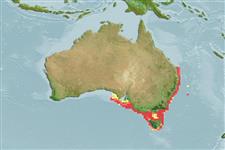>
Eupercaria/misc (Various families in series Eupercaria) >
Sillaginidae (Smelt-whitings)
Etymology: Sillago: From a locality in Australia.
Eponymy: Matthew Flinders (1774–1814) was an English explorer and navigator who joined the British Navy and trained as a navigator, having wanted to be a sailor and explorer ever since reading Robinson Crusoe. [...] (Ref. 128868), visit book page.
Environment: milieu / climate zone / depth range / distribution range
экология
морской демерсальный; мигрирует в океане (Ref. 51243); пределы глубины 1 - 180 m (Ref. 6205), usually ? - 80 m (Ref. 27575). Temperate; 25°S - 44°S, 132°E - 154°E
Western Pacific: southern Queensland to Anxious Bay, South Australia, and the east coast of Tasmania.
Length at first maturity / Size / Вес / Возраст
Maturity: Lm 14.5, range 14 - 16 cm
Max length : 32.0 cm TL самец/пол неопределен; (Ref. 6335); наибольший возраст (опубликованны данные): 7 годы (Ref. 27578)
колючие лучи спинного плавника (общее число) : 12; членистые (мягкие) лучи спинного плавника (общее число) : 16 - 18; колючие лучи анального плавника: 2; членистые (мягкие) лучи анального плавника: 18 - 20; позвонки: 32 - 34. Coloration is very similar to S. bassensis. No dark spot at the base of the pectoral fin; a series of oblique rusty brown bars on back and upper sides, with a longitudinal row of rusty brown blotches along the midlateral silver stripe.
Live close to the sea bed over sandy substrates. They normally inhabit depths from the surf zone to 80 m (Ref. 27575), although small catches have been taken from deeper water (Ref. 6335). Juveniles congregate in shallow water where they may be taken by line in large quantities. Feed mainly on crustaceans, amphipods, decapods, mysids and copepods. Juveniles consume mostly copepods (Ref. 6223). Oviparous (Ref. 205). Spawn from October to March in southern New South Wales but spawn in winter in southeast Queensland and northern New South Wales (Ref. 6205).
It is likely that this species spawn more than once during the spawning period, and that some eggs are resorbed by females at the end of the spawning season (Ref. 27577).
McKay, R.J., 1992. FAO Species Catalogue. Vol. 14. Sillaginid fishes of the world (family Sillaginidae). An annotated and illustrated catalogue of the sillago, smelt or Indo-Pacific whiting species known to date. Rome: FAO. FAO Fish. Synop. 125(14):87p. (Ref. 6205)
Статус Красного Списка МСОП (Ref. 130435: Version 2024-2)
Угроза для людей
Harmless
Использование человеком
рыболовство: важный объект промысла
дополнительная информация
инструменты
Специальные отчеты
Скачать в формате XML
ресурсы в Интернет
Estimates based on models
Preferred temperature (Ref.
123201): 14.1 - 20.1, mean 15.4 °C (based on 166 cells).
Phylogenetic diversity index (Ref.
82804): PD
50 = 0.5000 [Uniqueness, from 0.5 = low to 2.0 = high].
Bayesian length-weight: a=0.00832 (0.00351 - 0.01970), b=3.07 (2.86 - 3.28), in cm total length, based on LWR estimates for this (Sub)family-body shape (Ref.
93245).
Trophic level (Ref.
69278): 3.3 ±0.43 se; based on food items.
Generation time: 2.4 ( na - na) years. Estimated as median ln(3)/K based on 1
growth studies.
устойчивость к внешним воздействиям (Ref.
120179): средний (среднего размера), минимальное время удвоения популяции 1.4-4.4 года (K=0.46(?); tm=2; tmax=7; Fec=30,000).
Fishing Vulnerability (Ref.
59153): Low vulnerability (22 of 100).
